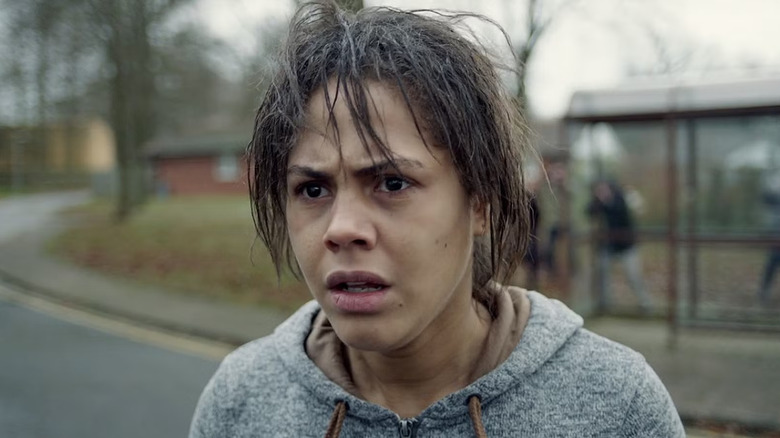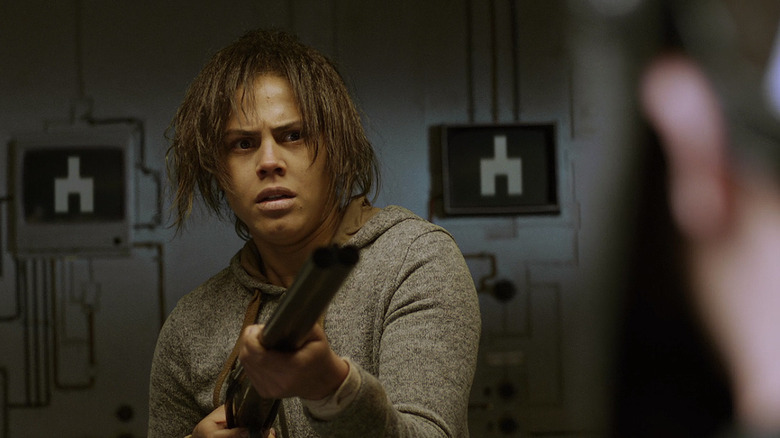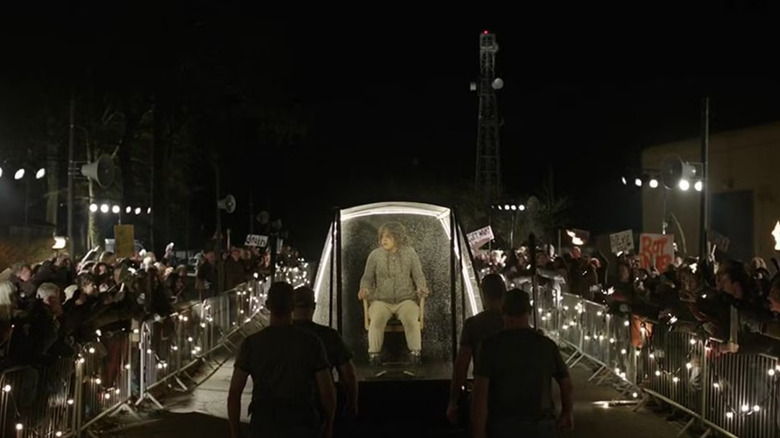One Of Black Mirror's Most Disturbing Episodes Has A Connection To A Real Tragedy
This article contains discussions of child abuse, mental health, sexual assault, and suicide.
In the second-ever series of Charlie Brooker's anthology series "Black Mirror" — back when it still aired on the UK's Channel 4 and before it migrated to Netflix — Brooker and director Charlie Tibbetts introduce a harrowing installment titled "White Bear." The episode opens as a woman named Victoria (Lenora Crichlow) wakes up in an empty house with a television showing an odd symbol; pictures of a man (Nick Ofield) and a little girl (Imani Jackman) surround her. Though Victoria tries to interact with various people in the seemingly empty suburb, they just take photos and videos of her on their phones instead, and though Victoria thinks she's saved when she meets two helpful strangers — who explain that the TV symbol she saw makes people into passive gawkers — there's more to this entire situation than she realizes.
Explaining the real-life inspiration for "White Bear" does "spoil" the ending, so to speak, but it's important to recognize that Brooker based this on a horrifying string of real-life murders. In 2017, The New York Times reminded the world of abominations dubbed "the Moors murders" when one of the killers, Ian Brady, died in what the outlet described as a "a high-security psychiatric hospital" in England. Brady and his girlfriend, Myra Hindley, who were 27 and 23 years old at the time, abducted, tortured, sexually assaulted, and killed five children and teenagers named Edward Evans, Keith Bennett, Pauline Reade, Lesley Ann Downey, and John Kilbride. During their assault on Downey, Brady and Hindley created audio recordings and took photographs of their depraved crimes.
Evans' body was found in Brady's house, Bennett's was never found, and Reade, Downey, and Kilbride were buried in shallow graves on Saddleworth Moor in a remote part of England, hence the name "the Moors murders." So, how do these true horrors translate into a "Black Mirror" episode?
White Bear adds a disturbing layer to the true story of the Moors murders
The people who "rescue" Victoria — Jem and Baxter, played by Tuppence Middleton and Michael Smiley — don't reveal any of their true intentions to Victoria, and things seem to take a turn when Baxter puts a bag over Victoria's head and leads the two women into the woods. In a remote area of the forest, there's a woman hanging from a cross — a reference that ties to Charlie Brooker's original vision of the episode, which I'll circle back to shortly — and Baxter is about to torture both women with a drill, but Jem attacks him, leaving him for dead as she and Victoria escape. Victoria manages to get hold of a shotgun as a different man, who's wearing a mask with that same strange symbol on it, attacks her ... but only confetti fires out of the gun, at which point the episode's big twist is revealed.
That symbol isn't making people into voyeurs; Victoria is the central attraction of a deeply twisted theme park where she's "hunted" by masked aggressors every day, "saved" by Jem and Baxter, and chased by visitors holding their cell phones high. It's then revealed that Victoria and her fiancé, Iain Rannoch, the man whose picture she saw in the apartment, abducted, tortured, and killed a little girl named Jemima, whose photo is hastily wedged into the frame that holds a picture of Victoria and Iain together. Specifically, Iain committed these horrifying acts against a small child, and Victoria passively stood by and videotaped the entire encounter. At the end of each day at the park, Victoria's memories are reset.
Every single day for the rest of Victoria's life, she's psychologically tortured in a park called White Bear Justice Park, named for the toy Jemima loved most. Iain, whose distinctive tattoo is the same as that symbol that keeps appearing throughout the episode, died by suicide in police custody, leaving Victoria to face her fate alone. It's a deeply troubling episode, and it also feels particularly harrowing because at first, you can't help but identify with a frightened Victoria; when you learn about her crimes, it's instinctive to turn on her and feel as if this is, perhaps, all justified in Jemima's name. "White Bear" may be one of the best episodes of "Black Mirror" overall, but it's a tough watch ... and the way it manipulates its audience is both impressive and deeply unsettling.
Originally, White Bear had a different focus — according to Charlie Brooker
According to a chat that Charlie Brooker had with Variety after the episode aired, he revealed that originally, "White Bear" wasn't connected to any real-life events at all. In fact, it was simpler ... but honestly, just as messed up. "It was a straightforward apocalypse story," he noted. "It was a woman wakes up and there's a signal going across the world affecting people. The original ending had a public crucifixion."
Then, Brooker felt inspired by the former U.S. military base they used for filming — specifically, a site called RAF Daws Hill, located in the southeastern part of England — and reworked the entire thing. "We were looking around at what we could use," he said. "I saw the housing, a gas station, and I saw this fence running around outside the place. I was like, 'That's interesting, there's a fence. A fence. A fence!' And the twist suddenly occurred to me. I ran off and wrote it in a couple days in a bit of a fever dream." The "Moors murders" are quite famous in England, so it's not that big of a leap to see how Brooker arrived at an idea where normal people can gawk at and even "hunt" notorious killers. Still, I cannot understate just how twisted Brooker's mind is, because taking this setting to its most extreme point is still unbelievably jarring.
"We were ready to go, we were scouting," Brooker concluded. "It was Darwinian in that such a better idea came along." The rest is TV history. "White Bear," along with the rest of "Black Mirror," is streaming now.
If you or someone you know may be the victim of child abuse, please contact the Childhelp National Child Abuse Hotline at 1-800-4-A-Child (1-800-422-4453) or contact their live chat services.
If you or someone you know needs help with mental health, please contact the Crisis Text Line by texting HOME to 741741, call the National Alliance on Mental Illness helpline at 1-800-950-NAMI (6264), or visit the National Institute of Mental Health website.
If you or anyone you know has been a victim of sexual assault, help is available. Visit the Rape, Abuse & Incest National Network website or contact RAINN's National Helpline at 1-800-656-HOPE (4673).
If you or someone you know is struggling or in crisis, help is available. Call or text 988 or chat 988lifeline.org


